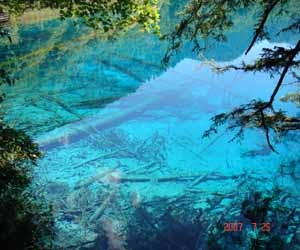 Jiuzhaigou Valley is located in the south of the Minshan mountain, 330 km north of Chengdu(capital city of Sichuan province). It is near the Gansu border.
Jiuzhaigou Valley is located in the south of the Minshan mountain, 330 km north of Chengdu(capital city of Sichuan province). It is near the Gansu border.
JiuZhaiGou covers about 240 square KM. Its altitude ranges from 1,998 to 4,764 meters.
The meaning of Jiuzhaigou is “nine villages valley”.There are nine Tibetan villages in JiuZhaiGou.Seven of them are still populated today.
JiuZhaiGou has lots of notable features and many famous movies are taken here. It is called “heaven in the earth” by the local people.
The Primeval Forest is a preserved ancient woodland. It is fronted by spectacular views of the surrounding mountains and cliffs, including the 500 m high blade-shaped Sword Rock.
Swan Lake is a 2250 m long, 125 m wide picturesque lake named for its visiting swans and ducks.
Grass Lake is a shallow lake covered in intricate vegetation patterns.
Arrow Bamboo Lake covering an area of 170,000 square meters, is a shallow lake with a depth of 6 m. It lies at an elevation of 2,618 m, and was a main feature site for the 2002 Chinese film Hero.
Panda Lake features curious color patterns of blue and green. It empties into the multi-stream, multi-level Panda Waterfalls, dropping 78m in 3 steps.
Five Flower Lake is a shallow multi-colored lake whose bottom is criss-crossed by ancient fallen tree trunks.
Pearl Shoal is a wide, gently sloping area of active calcareous tufa deposition covered in a thin sheet of flowing water. It empties into the famous Pearl Waterfalls, where the shoal drops 28 m in a 310 m wide broad curtain of water. A scene of the television adaptation of Journey to the West was filmed there.
Mirror Lake is another quiet lake casting beautiful reflections of the surroundings when the water is calm.
The Zechawa Gully is the south-eastern branch of Jiuzhaigou. It is approximately the same length as Rize gully (18 km ) but climbs to a higher altitude (3150 m at the Long Lake). Going downhill from its highest point, it features the following sites:
Long Lake is the highest, largest and deepest lake in Jiuzhaigou, measuring 7.5 km in length and up to 103 m in depth. It reportedly has no outgoing waterways, getting its water from snow melt and losing it from seepage. Local folklore features a monster in its depths.
Five-Color Pond is one of the smallest but most spectacular bodies of water in Jiuzhaigou lakes. Despite its very modest dimensions and depth, it has a richly colored underwater landscape with some of the brightest and clearest waters in the area.
The Seasonal Lakes are a series of 3 lakes (Lower, Middle and Upper) along the main road, that change from empty to full during each year.
The Shuzheng Valley is the northern (main) branch of Jiuzhaigou. It ends after 14.5 km at the Y-shaped intersection of the three gullies. Going downhill from the intersection to the mouth of the valley, visitors encounter the following:
Nuorilang Falls near the junction of the valleys, are 20 m high and 320 m wide. They are reportedly the widest highland waterfall in China, and one of the symbols of Jiuzhaigou.
Nuorilang Lakes and Shuzheng Lakes are stepped series of respectively 18 and 19 ribbon lakes formed by the passage of glaciers, then naturally dammed. Some of them have their own folkloric names, such as the Rhinoceros, Unknown, and Tiger lakes.
Sleeping Dragon Lake is one of the lower lakes in the area. With a depth of 20 m, it is notable for the clearly visible calcareous dyke running through it, whose shape has been compared to a dragon lying on the bottom.
Reed Lake is a 1375m-long, reed-covered marsh with a clear turquoise brook zigzaging through it. The contrast is particularly striking in the autumn when the reeds turn yellow.
[Source:wikipedia]
